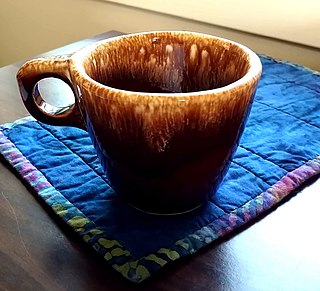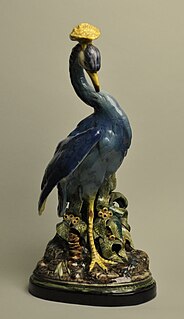
Paducah is a home rule-class city in and the county seat of McCracken County, Kentucky, United States. The largest city in the Jackson Purchase region, it is located at the confluence of the Tennessee and the Ohio rivers, halfway between St. Louis, Missouri, to the northwest and Nashville, Tennessee, to the southeast. The population was 24,850 in 2018, down slightly from 25,024 during the 2010 U.S. Census. Twenty blocks of the city's downtown have been designated as a historic district and listed on the National Register of Historic Places.

Red Wing is a city in Goodhue County, Minnesota, United States, along the upper Mississippi River. The population was 16,459 at the 2010 census. It is the county seat of Goodhue County.

The Cumberland River is a major waterway of the Southern United States. The 688-mile-long (1,107 km) river drains almost 18,000 square miles (47,000 km2) of southern Kentucky and north-central Tennessee. The river flows generally west from a source in the Appalachian Mountains to its confluence with the Ohio River near Paducah, Kentucky, and the mouth of the Tennessee River. Major tributaries include the Obey, Caney Fork, Stones, and Red rivers.
Studio pottery is pottery made by professional and amateur artists or artisans working alone or in small groups, making unique items or short runs. Typically, all stages of manufacture are carried out by the artists themselves. Studio pottery includes functional wares such as tableware and cookware, and non-functional wares such as sculpture. Studio potters can be referred to as ceramic artists, ceramists, ceramicists or as an artist who uses clay as a medium. Much studio pottery is tableware or cookware, but an increasing number of studio potters produce non-functional or sculptural items. In Britain since the 1980s, there has been a distinct trend away from functional pottery, for example, the work of artist Grayson Perry. Some studio potters now prefer to call themselves ceramic artists, ceramists or simply artists. Studio pottery is represented by potters all over the world and has strong roots in Britain.

Van Briggle Art Pottery was at the time of its demise the oldest continuously operating art pottery in the United States, having been established in Colorado Springs, Colorado in 1901 by Artus and Anne Van Briggle. Artus had a significant impact on the Art Nouveau movement in the United States, and his pottery is foundational to American Art Pottery. The Art Nouveau style favored by its founders continues to influence the pottery's designs.

Hull pottery began production in 1905 in Crooksville, Ohio, under the leadership of Addis Emmet (A.E.) Hull. The Hull Pottery Company's early lines consisted of common utilitarian stoneware, semi-porcelain dinnerware and decorative tile. The company quickly established a firm market and enjoyed an excellent reputation for producing quality ceramics.

Blue Ridge is a type of American dishware manufactured by Southern Potteries Incorporated from the 1930s until 1957. Well known in their day for their underglaze decoration and colorful patterns, Blue Ridge pieces are now popular items with collectors of antique dishware. The underglaze technique made the decorations more durable, and while basic patterns were reused consistently, the fact that each piece was hand-painted means that no two pieces are exactly alike.
The Homer Laughlin China Company is an American ceramics manufacturer located in Newell, West Virginia, United States, which is best known for producing the Fiesta line of dinnerware. Homer Laughlin is one of two potteries under the HLC Inc. brand, the other being Hall China.

The Lincoln Heritage Council (LHC) is a local council of the Boy Scouts of America serving 64 counties in four states: Kentucky, Indiana, Illinois, and Tennessee.
The Fostoria Glass Company manufactured pressed, blown and hand-molded glassware and tableware for almost 100 years. It began operations in Fostoria, Ohio, on December 15, 1887, on land donated by the townspeople. The new company was formed by men from West Virginia, who were experienced in the glassmaking business. They started their company in northwest Ohio to take advantage of newly discovered natural gas that was an ideal fuel for glassmaking. Numerous other businesses were started in the area, and the supply of natural gas began to diminish. Fuel shortages caused the company to move to Moundsville, West Virginia in 1891.

Mississippian culture pottery is the ceramic tradition of the Mississippian culture found as artifacts in archaeological sites in the American Midwest and Southeast. It is often characterized by the adoption and use of riverine shell-tempering agents in the clay paste. Shell tempering is one of the hallmarks of Mississippian cultural practices. Analysis of local differences in materials, techniques, forms, and designs is a primary means for archaeologists to learn about the lifeways, religious practices, trade, and interaction among Mississippian peoples. The value of this pottery on the illegal antiquities market has led to extensive looting of sites.

Pacific Clay Products, founded 1892, was created by the merger of several Southern California potteries. The company began producing utilitarian pottery in the 1920s, and introduced solid color earthenware dinnerware in 1932. The primary site for the production of ceramic tableware, kitchenware, and art ware was based in the company's Lincoln Heights, Los Angeles plant at 306 West Avenue 26. Pacific Clay ceased production of ceramic dinnerware and art ware in 1942. After 1942, Pacific Clay produced sewer tile and brick. The company ceased production of sewer tile in 1997. The company continues to produce brick products in Lake Elsinore, California. The company has been owned by David H. Murdock since 1973.

California pottery includes industrial, commercial, and decorative pottery produced in the Northern California and Southern California regions of the U.S. state of California. Production includes brick, sewer pipe, architectural terra cotta, tile, garden ware, tableware, kitchenware, art ware, figurines, giftware, and ceramics for industrial use. Ceramics include terra cotta, earthenware, porcelain, and stoneware products.
The Paducah Chiefs are a collegiate summer baseball league baseball team in Paducah, Kentucky. The Chiefs were the primary nickname for various Paducah minor league teams, who first began play in 1897.

The Shawnee Pottery Company was a manufacturing company best known for producing Corn King pottery and the Pennsylvania Dutch lines of pottery. Both of these lines are considered to be highly collectible.
Nancy Morrison Crow is an American art quilter and fiber artist. She is one of the leading figures in the development of the art quilting movement of the 1970s and 1980s, and is also known for her development of certain techniques to allow more spontaneity and expression.
Samuel Augustus Weller, one of the pioneer pottery manufacturers of Ohio in the United States, founded the S.A. Weller Pottery in Fultonham, Ohio, in 1872. In 1882 he moved the business to Zanesville, Ohio, and for more than a half-century Weller Pottery produced both utilitarian pieces and more decorative art pottery lines.

American art pottery refers to aesthetically distinctive hand-made ceramics in earthenware and stoneware from the period 1870-1950s. Ranging from tall vases to tiles, the work features original designs, simplified shapes, and experimental glazes and painting techniques. Stylistically, most of this work is affiliated with the modernizing Arts and Crafts (1880-1910), Art Nouveau (1890–1910), or Art Deco (1920s) movements. Art pottery was made by some 200 studios and small factories across the country, with especially strong centers of production in Ohio and Massachusetts. Most of the potteries were forced out of business by the economic pressures of competition from commercial mass-production companies as well as the advent of World War I followed a decade later by the Great Depression.
Karl Martz was an American studio potter, ceramic artist, and teacher whose work achieved national and international recognition.














